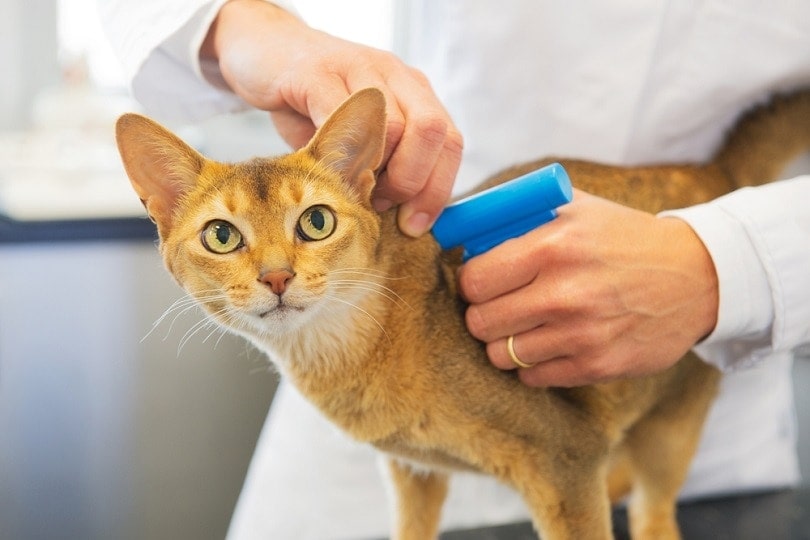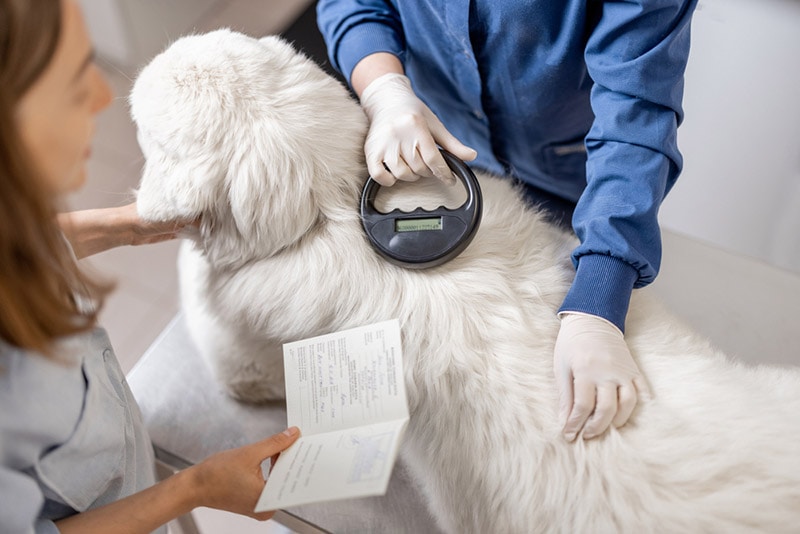When Is National Microchipping Month? 2024 Update & How To Celebrate
Updated on

Click to Skip Ahead
Almost nothing is worse than the gut-wrenching horror of realizing your beloved pet is missing. If you are fortunate enough to realize very soon after they abscond, they may be located and quickly returned home safely. However, that is not always the case.
Microchipping uses a permanent and unremovable device that can be implanted in almost any pet. To celebrate and raise awareness for this most valuable tool available to pet owners, National Microchipping Month is recognized in June of every year.
How Did National Microchipping Month Come About?
There’s no clear information available that tells us when National Microchipping Month was first celebrated. Confusingly, National Chip Your Pet Month is celebrated in May of each year. We think it’s great that two whole months are dedicated to raising awareness for this effective means of pet identification. There is no difference between the two events, and we could speculate that they may previously have been the same event that became two through a mix-up.
The May event, National Chip Your Pet Month, was created by the AKC to provide information about microchipping and to highlight the benefits thereof. Following the above supposition, this may be precisely how National Microchipping Month also came into existence.

How Does Microchipping Work?
Microchipping an animal is a primarily safe procedure that causes them very little distress, other than what would usually be experienced visiting the vet! During the procedure, a tiny device, no bigger than a grain of rice, is inserted under the skin using a specialized hypodermic needle-like instrument. While the process is not entirely painless—it feels like a sharp sting that is over quickly—it is unlikely to cause the animal lingering trauma.
The tiny little device is composed of four components: the outside covering, capacitor, antenna, and connecting wire. The antenna picks up a radio frequency emitted by the scanner, which activates the microchip and transmits its information to the operator. The chip doesn’t contain a battery but operates via electromagnetic induction-induced electricity.
Microchips are usually implanted between the shoulder blades beneath the skin. This is an area that is amenable to the procedure and the place that will be first scanned for a microchip. Microchips do not permit animals to be tracked or traced as they do not emit a GPS signal.

Is Microchipping Failsafe?
Microchipping your beloved pet hugely increases your chances of being reunited should you ever experience unintentional separation. However, like many technologies, it is not a failsafe and has some limitations. A microchip is only effective if it can be scanned.
For this to happen, your lost pet must end up in a facility with a scanner. While the chances of this happening are excellent, it’s not always a given. Additionally, the good Samaritan on the street who rescues your lost pup doesn’t have a scanner. It’s, therefore, always best to have a collar and tag as your pet’s primary source of identification.
Not all microchips operate at the same frequency, and if the facility where your pet has been rescued does not have a universal scanner, they might be unable to read off your pet’s information.
A final consideration is that a microchip is only as good as the information stored on it. Owners of chipped animals must keep their contact details up to date on the chip. Out-of-date contact details on a microchip are reportedly one of the biggest reasons microchipped pets are not reunited with their owners.

Should I Microchip My Pet?
Ultimately, the decision to microchip your pet is yours unless you reside in an area that has mandated it. The benefit of attaching a fixed form of identification to your pet is clear. However, you may have personal concerns, both ethical and safety-related, regarding the implantation of a foreign object in your pet’s body.
While the procedure has been proven to be extremely safe, there are rare reports of localized reactions to the procedure or migration of the chip within the animal’s body. Some pet owners may be concerned about unnecessary exposure to electromagnetic activity due to the implanted chip. Experts agree, however, that the benefits of microchipping far exceed any potential risks.
Although collars and tags are a great immediate form of identification that could save time and prevent trauma to both you and your lost pet, they are not entirely reliable. Pets can easily slip out of them, they can fall off, or they can be removed. Microchipping is a sensible backup to a collar and tag or an alternative for pets that won’t tolerate one.

What Should I Do During National Microchipping Month?
If you haven’t already had your cherished pets microchipped, National Microchipping Month is a great time to get it done! You may even find some vets and shelters offering a discount or free service during this month or on a particular day to raise awareness and get more animals chipped.
If your pet is already chipped, then National Microchipping Month is a great reminder to ensure that the details on your pet’s chip are up-to-date and that the chip is working properly. You can book an appointment with your veterinarian to ensure their chip is in full working order.
Another great way to celebrate this month and bring awareness to the enormous benefits of microchipping pets is to talk about it. Bring it up in conversation with your animal-loving friends and acquaintances and post about it on social media. Many people are either ignorant about microchipping or badly informed. A little bit of information shared could help save an animal’s life.

Conclusion
There’s no doubt that microchipping your pet is advantageous. There is always the chance that your beloved pet might get lost or otherwise go missing.
Microchipping and scanning animals are becoming more common. A lost, microchipped pet has a much greater chance of being reunited with their family. Let June of each year be your annual reminder to check that your pet’s microchip is functioning correctly and the details are current. It’s also your chance to provide any new four-legged additions to the family with microchips.
Featured Image Credit: LightField Studios, Shutterstock











